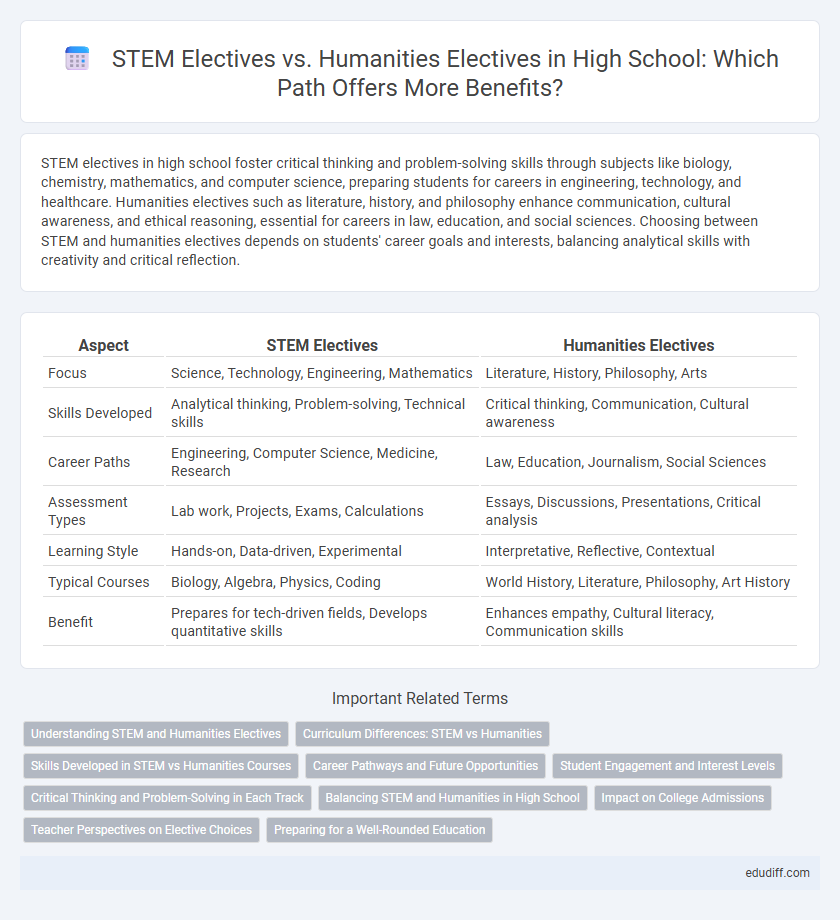STEM electives in high school foster critical thinking and problem-solving skills through subjects like biology, chemistry, mathematics, and computer science, preparing students for careers in engineering, technology, and healthcare. Humanities electives such as literature, history, and philosophy enhance communication, cultural awareness, and ethical reasoning, essential for careers in law, education, and social sciences. Choosing between STEM and humanities electives depends on students' career goals and interests, balancing analytical skills with creativity and critical reflection.
Table of Comparison
| Aspect | STEM Electives | Humanities Electives |
|---|---|---|
| Focus | Science, Technology, Engineering, Mathematics | Literature, History, Philosophy, Arts |
| Skills Developed | Analytical thinking, Problem-solving, Technical skills | Critical thinking, Communication, Cultural awareness |
| Career Paths | Engineering, Computer Science, Medicine, Research | Law, Education, Journalism, Social Sciences |
| Assessment Types | Lab work, Projects, Exams, Calculations | Essays, Discussions, Presentations, Critical analysis |
| Learning Style | Hands-on, Data-driven, Experimental | Interpretative, Reflective, Contextual |
| Typical Courses | Biology, Algebra, Physics, Coding | World History, Literature, Philosophy, Art History |
| Benefit | Prepares for tech-driven fields, Develops quantitative skills | Enhances empathy, Cultural literacy, Communication skills |
Understanding STEM and Humanities Electives
STEM electives such as biology, computer science, and engineering enhance analytical skills and technical knowledge essential for innovation and problem-solving in science and technology fields. Humanities electives like literature, history, and philosophy develop critical thinking, communication, and cultural awareness by exploring human experiences and ethical considerations. Balanced exposure to both STEM and humanities electives fosters well-rounded intellectual growth and prepares students for diverse academic and career pathways.
Curriculum Differences: STEM vs Humanities
STEM electives in high school emphasize math, science, and technology courses that develop analytical and problem-solving skills through hands-on experiments and coding projects. Humanities electives focus on literature, history, and philosophy, fostering critical thinking and interpretive analysis through essay writing and discussion-based learning. The curriculum differences showcase STEM's quantitative approach contrasted with Humanities' qualitative exploration.
Skills Developed in STEM vs Humanities Courses
STEM electives cultivate analytical thinking, problem-solving abilities, and technical skills essential for careers in science, technology, engineering, and mathematics. Humanities electives enhance critical reading, writing, communication, and cultural awareness, fostering empathy and creative expression. Both pathways develop complementary skill sets that prepare students for diverse academic and professional pursuits.
Career Pathways and Future Opportunities
STEM electives such as computer science, engineering, and biology provide high school students with critical technical skills and knowledge that align with rapidly growing career pathways in technology, healthcare, and research industries. Humanities electives like literature, history, and philosophy develop analytical thinking, communication, and cultural awareness, which are essential for careers in law, education, and public service. Choosing electives based on personal interests and strengths can enhance college readiness and open diverse future opportunities in both specialized STEM fields and broad humanities disciplines.
Student Engagement and Interest Levels
STEM electives often attract students with a strong interest in technology, engineering, mathematics, and science, fostering hands-on learning and problem-solving skills that boost engagement. Humanities electives engage students passionate about literature, history, philosophy, and social sciences, promoting critical thinking and empathy through discussion and analysis. Schools offering a balanced mix of STEM and humanities electives tend to see higher overall student participation and sustained interest by catering to diverse intellectual preferences.
Critical Thinking and Problem-Solving in Each Track
STEM electives emphasize critical thinking through analytical problem-solving, mathematical modeling, and scientific inquiry, sharpening students' ability to tackle complex technical challenges. Humanities electives foster critical thinking by encouraging interpretation, ethical reasoning, and argument analysis, cultivating effective communication and nuanced understanding of diverse perspectives. Both tracks develop problem-solving skills tailored to their disciplines, preparing students for varied real-world situations and interdisciplinary collaboration.
Balancing STEM and Humanities in High School
High school students benefit from balancing STEM electives, such as biology, physics, and computer science, with humanities courses like literature, history, and philosophy to develop well-rounded critical thinking and problem-solving skills. Integrating both STEM and humanities fosters creativity, ethical reasoning, and cultural awareness, essential for success in diverse career paths. Schools that encourage interdisciplinary learning promote cognitive flexibility and better prepare students for the complexities of modern society.
Impact on College Admissions
STEM electives in high school often enhance college applications for competitive programs in science, technology, engineering, and mathematics by demonstrating strong analytical and problem-solving skills. Humanities electives, such as literature and history, showcase critical thinking, communication abilities, and cultural awareness, appealing to liberal arts and interdisciplinary programs. Admissions officers value a balanced curriculum that highlights both STEM proficiency and humanities insight, reflecting a well-rounded academic profile.
Teacher Perspectives on Elective Choices
High school teachers observe that students selecting STEM electives often demonstrate strong analytical skills and a preference for practical problem-solving, while those choosing humanities electives exhibit critical thinking and enhanced communication abilities. Educators emphasize that STEM electives prepare students for technology-driven careers, whereas humanities cultivate empathy and cultural awareness essential for societal engagement. Teacher perspectives highlight the importance of balanced elective offerings to cater to diverse student interests and future career pathways.
Preparing for a Well-Rounded Education
STEM electives in high school build critical skills in science, technology, engineering, and math, fostering analytical thinking and problem-solving abilities essential for future careers. Humanities electives complement this by enhancing communication, cultural awareness, and ethical reasoning, key for personal development and societal understanding. Balancing STEM and humanities courses ensures students develop a well-rounded education, equipping them with both technical expertise and critical soft skills for diverse opportunities.
STEM electives vs Humanities electives Infographic

 edudiff.com
edudiff.com